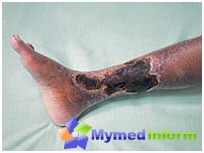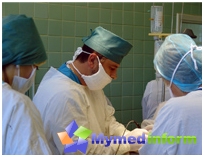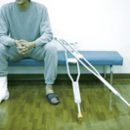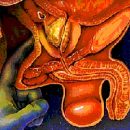What happened gangrene? Types of gangremen: gas, acute, atherosclerotic, gangrene when frostbite.
Content
gangrene
When frostbite
Gangrene
Gangrena - massive oversonation (necrosis) fabrics
living organism. The cause of the development of gangrenes may be damage
fabrics with any physical effects (for example, deep
frostbite), violation of blood supply to tissues or organs with different
diseases as well as infections. Gangrena can develop in different
fabrics and organs, but most often occurs gangrene limbs for
which is characterized by the darkening (blackening) of the skin. Most
Common gas gangrene, acute gangrene and atherosclerotic
gangrene.
Gas gangrene

Gas
Gangrena arises as a result of infection of wounds by clostridia -
Bacteria genus Clostridium. They form disputes and are strict
Anaerobami, T.E. for their livelihoods need a complete absence
Oxygen. Pathogenic clostridium is widespread in the soil and usually
enter the body with penetrating injuries of muscle tissue (deep
Cheerful or ripped wounds). IN
muscles, where favorable conditions are created for the reproduction of these
bacteria, clostridium produce toxins that penetrate into
surrounding tissues and kill cells. Infection quickly spreads, and
Estimated with bacteria Special enzymes split proteins and carbohydrates
damaged tissues with gas formation.
Gas
Gangrena develops gradually. Her first symptoms are severe pain and
swelling of the fabrics around the wound. Then appear browned selection
From the wound, a malware smell, the skin becomes dark or bronze. IN
typical cases accumulating in the affected tissues causes
Characteristic crackling (attitudes) with a slight touch to
Skin surfaces.
Treatment
- surgical; Uncrolized tissue is completely removed (amputated
The whole area within healthy fabrics) and provide fluid outflow
(drainage) from surrounding tissues. To prevent development
Secondary infection use antibiotics.
Acute gangrene
Acute
Gangrena is caused by bacteria that are optional anaerobes.
They usually multiply in oxygen-containing environment, but can
develop in the absence of oxygen. These include intestinal wand
(Escherichia), aerobacteria (Aerobacter), Streptococci (Streptococcus).
More often
All acute gangrene causes hemolytic streptococcus hemolytic.
Atherosclerotic
gangrene
The reason for it is atherosclerosis, accompanied by a narrowing
lumen or complete blockage (obliteration) of vessels, which reduces
Or completely stops blood supply to fabrics. In the case of joining
Secondary infection develops wet gangrene, while
The uncomplicated form proceeds by the type of dry gangrene. In patients
Sugar diabetes atherosclerosis and as a result of his gangrene meet
much more often than those who do not suffer from diabetes.
Initial
The manifestation of gangrenes is the decrease in the temperature of the lower extremities or
only stop or fingers. Later skin acquires a shiny
(cyanotic) shade, then becomes black. Displays painted
skin strip, called the demarcation line, shares live and
Uncrolished fabric.
At
This form of gangremen is very important to introduce antibiotics to
Prevent secondary infection. When the demarcation line
formed, amputation above this line.
Gangrene
When frostbite
Severe frostbite causes destruction of cells and
Tissue necrosis in the damaged area. In the case of deep frostbite
Inside vessels, blood clots (blood clots) are formed that impede
Bloodstock and contribute to the development of gangrene. As soon as he was formed
Demarkation line, an dead body of the body amputated.









